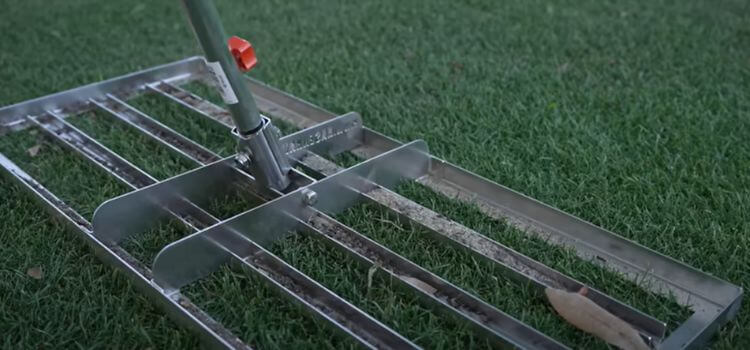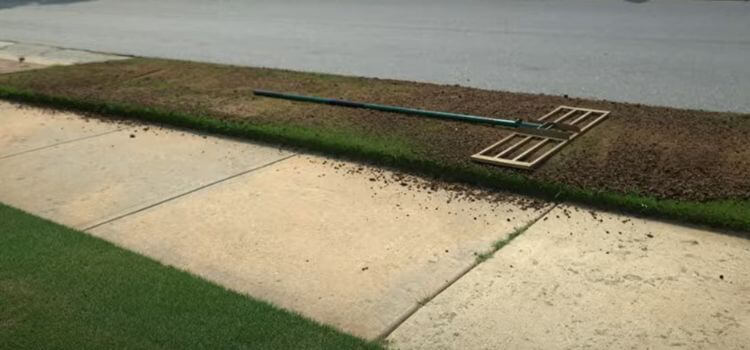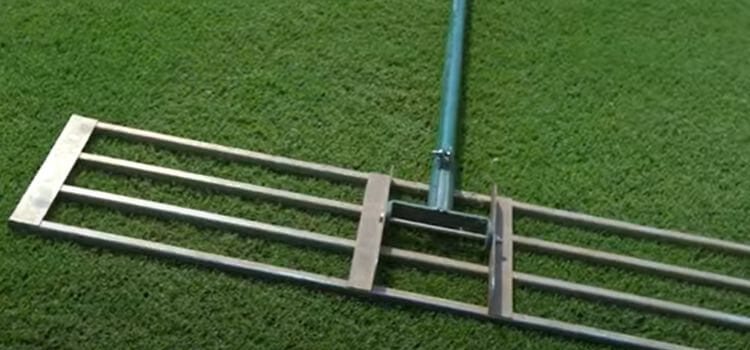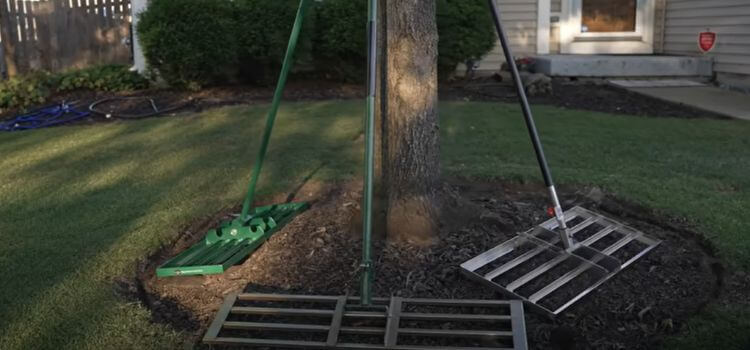As an Amazon Associate, I earn from qualifying purchases.
A lawn levelling rake helps to distribute topdressing materials evenly across the grass. It smooths out any bumps or depressions for a flat, well-groomed lawn.
Creating a perfectly level lawn is essential for both aesthetic appeal and lawn health. Using a lawn levelling rake simplifies this task, making it accessible to homeowners and professional landscapers alike. The rake’s design, featuring a wide, flat head with tines, allows for the efficient spreading of soil, sand, or compost.
This process encourages better water absorption, reduces the risk of mower scalping, and promotes an even growth pattern. As a user drags the rake over the lawn, the topdressing fills in low spots while excess material is scraped away from the high areas, resulting in a level and playable lawn surface.

Elements Of A Lawn Leveling Rake
A lawn levelling rake operates through its key components: a flat, wide head and sturdy, adjustable handles. This specialized tool evenly distributes topsoil or sand, smoothing out uneven grass for a well-manicured lawn.
The lawn levelling rake is essential for creating a smooth, even lawn surface. Understanding its components can help you use it effectively. This tool mainly includes two parts: the handle and the levelling head.
Types Of Rakes
Lawn levelling rakes come in different types:
- Flat-headed rakes: Great for pushing soil and sand evenly.
- Bar-headed rakes: Useful for breaking up clumps and levelling.
Each type suits different lawn care needs.
Handle And Leveling Head
The handle and levelling head are crucial for operation:
- Handle: Usually made of wood or metal, it provides grip and control.
- Leveling Head: Attached at the bottom, it spreads materials flat.
These parts work together to improve lawn texture.
| Component | Material | Function |
|---|---|---|
| Handle | Wood or Metal | Provides grip and control |
| Leveling Head | Metal Mesh | Spreads and flattens soil |
By knowing these components, you can choose the right rake for your lawn.
How Does a Lawn Leveling Rake Work?
Understanding the Working Mechanism of a lawn levelling rake is crucial for achieving a smooth and even garden.
Breaking Up Soil
The first step in using a lawn levelling rake involves breaking up compacted soil. This is vital for promoting better water absorption and root growth. The rake’s sharp, sturdy tines penetrate the soil, effectively loosening it. This process prepares the ground for further levelling and seeding.
- Insert the rake into the soil at a slight angle.
- Pull back gently to churn the earth.
- Repeat across the area you wish to level.
Leveling The Surface
Once the soil is loose, the next step is to level the surface. The flat part of the rake comes into play here, smoothing out bumps and filling in dips. This ensures a flat, even lawn surface that is ideal for gardening and has aesthetic appeal.
- Push the rake forward to spread the soil evenly.
- Drag the flat side of the rake across the surface.
- Ensure all areas are smooth and even.
Using a lawn levelling rake not only improves the appearance of your lawn but also enhances its health. By following these steps, you can achieve a perfectly levelled lawn that is both beautiful and beneficial for plant growth.

How to Use A Lawn Leveling Rake?
Levelling a lawn can transform a bumpy yard into a smooth haven. A lawn levelling rake makes this job easier. It spreads soil or sand over low spots effectively. For the best results, follow these best practices when using a lawn levelling rake.
Choosing The Right Time
Timing is crucial for lawn care. Spring or early fall is the best time to level your lawn. During these seasons, grass recovers faster. Ensure the soil is moist but not soggy. This makes it easier for the levelling mix to settle.
Techniques For Effective Leveling
Using the rake properly is key to an even lawn. Here are step-by-step techniques:
- Mow the lawn to a short length. This exposes bumps and low spots.
- Mix sand or soil with compost. This helps with grass growth.
- Spread the mix over the lawn’s surface with the rake.
- Use back-and-forth motions to distribute the mix evenly.
- Apply slight pressure to work the mix into the lawn.
- Water lightly after levelling to help the soil settle.
Remember to start from one corner and work your way across the lawn. Be gentle around new grass to avoid damage.
Benefits Of Using A Lawn Leveling Rake
The benefits of using a lawn levelling rake are vast and can significantly enhance the appearance and health of your lawn. A lawn levelling rake, also known as a lawn lute, soil leveller, or levelling drag, is a tool designed to even out and smooth the surface of your garden. Its use results in a more aesthetically pleasing lawn and can improve overall grass health.
Improvement In Grass Health
Using a lawn levelling rake does wonders for your grass. It breaks up soil clumps and fills in low spots, creating a uniform surface. This process encourages stronger root growth and allows for better nutrient absorption, which is crucial for a lush and vibrant lawn.
- Better air circulation within the soil
- Reduced risk of pest infestation and disease
- Enhanced access to sunlight for all blades of grass
Enhanced Water Distribution
Uniform water distribution is key to maintaining a green lawn. An uneven lawn can lead to water pooling in certain areas, causing both drought and overwatering conditions in different parts of your yard. A levelling rake helps ensure that water spreads evenly, reaching all parts of your grass. This leads to a more efficient irrigation system and can save water.
| Problem | Solution with Lawn Leveling Rake |
|---|---|
| Water pooling | Even distribution |
| Uneven irrigation | Improved coverage |
| Wasteful water runoff | Reduced waste |

Common Mistakes To Avoid
When striving for a picture-perfect lawn, using a lawn levelling rake is key. Yet, simple errors can hinder your progress. Understanding these common mistakes can transform your lawn care routine.
Overworking The Soil
Overworking the soil can lead to compaction and damage. Here’s what to avoid:
- Avoid repeated raking over the same area.
- Do not use the rake when the soil is too wet or too dry.
- Limit lawn levelling to once or twice a year.
Raking too often strips the soil of essential nutrients and disrupts root growth.
Uneven Pressure Application
Applying even pressure is crucial for a level lawn. Keep these points in mind:
| Correct Method | Incorrect Method |
|---|---|
| Use consistent, gentle strokes. | Avoid pressing down too hard. |
| Distribute weight evenly. | Do not use uneven force. |
| Move in varied directions. | Resist raking in one direction only. |
Uneven pressure can create dips and mounds in your lawn. Regular checks for uniformity are vital.
Maintenance Of Lawn Leveling Rake
Keeping your lawn levelling rake in top shape is vital for a healthy, smooth lawn. Regular maintenance ensures your tool lasts longer and works effectively. Below are some essential tips for maintaining your lawn levelling rake.
Cleaning And Storage
Clean your rake after each use to remove soil and grass. Use a hose or bucket of water to wash off debris. Dry the rake to prevent rust. Store it in a dry, cool place away from direct sunlight. Hang it up or keep it off the ground to avoid moisture damage.
- Wash with water
- Dry thoroughly
- Store indoors
- Avoid ground contact
Checking For Wear And Tear
Regularly inspect your rake for signs of wear. Look for bent tines or loose bolts. Tighten any loose parts. Replace parts if they are worn out or broken. This keeps the rake safe and functional.
| Check Area | Action |
|---|---|
| Tines | Look for bending |
| Bolts | Tighten if loose |
| Handle | Ensure it’s secure |
| Parts | Replace if needed |
- Inspect the rake
- Identify issues
- Fix problems
- Replace if necessary
A well-maintained lawn levelling rake makes lawn care easier. It helps you achieve that perfect, flat lawn. Follow these tips to ensure your rake stays in great condition for years to come.

FAQ On How Does a Lawn Leveling Rake Work?
A landscape rake, typically wider, helps clear debris and level soil in large areas. A levelling rake, often narrower, smooths out soil or gravel for a fine, even surface.
Lawn levelling involves evening out the ground by spreading a mixture of topsoil and sand over the grass. This process fills in low spots and promotes a flat, lush lawn.
Start by removing any debris from the surface. Rake the dirt evenly, applying consistent pressure. For low spots, distribute additional soil before raking. Use a levelling rake for larger areas to ensure evenness. Finally, cross-rake for a smooth, level finish.
The best tool to level ground is a landscaping rake for smaller areas or a motorized grader for larger spaces. Both ensure efficient and even ground levelling.
Conclusion
A lawn leveling rake is essential for creating a smooth, verdant landscape. Its unique design breaks down soil clumps and distributes top dressing evenly. Gardeners can use this tool to ensure a level lawn that not only looks professional but also promotes healthier turf growth.


